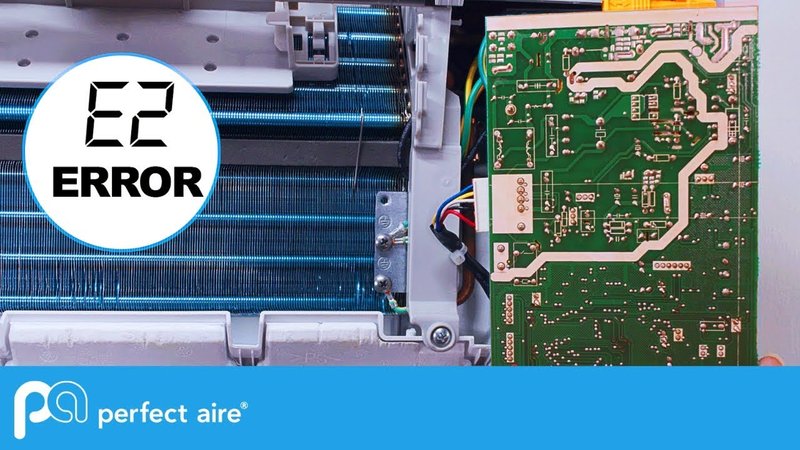
The “E2” error code might seem like a cryptic message from a futuristic device, but it’s really just your air conditioner’s way of saying something’s not quite right. Think of it like a car’s check engine light: an alert that something needs attention, but not necessarily an immediate cause for panic. In the world of Honeywell air conditioners, an “E2” error typically relates to sensor issues. Let’s dive into what this means and whether or not it’s safe to keep using your AC under these conditions.
Understanding the E2 Error Code
So, what’s the deal with the E2 error code? In layman’s terms, this error code usually indicates that there’s a problem with the temperature sensor of your air conditioner. Imagine it like your thermostat’s glasses getting smudged – it can’t really see the room temperature clearly anymore. This sensor is vital because it helps the air conditioner determine how much cooling is needed. If the sensor isn’t working properly, your AC might not cool efficiently, or it might run longer than necessary.
When the temperature sensor sends faulty readings, the air conditioner might respond by overcompensating, like an overly enthusiastic friend who gives you a thousand suggestions when you ask for one. This can lead to wasted energy and, ultimately, higher bills. The air conditioner might also cycle on and off erratically, which can be pretty annoying when you’re just trying to relax.
The good news is that an E2 error doesn’t mean your air conditioner is about to explode or something equally as dramatic. However, it’s a sign that some maintenance might be needed. Understanding what’s behind the code can help you decide the best course of action. Let’s talk about what you can do next to address this.
Common Causes and Fixes for the E2 Error
You might be wondering, “What causes the E2 error in the first place?” Well, several factors could lead to this annoying little message popping up on your AC’s display. Most commonly, it’s due to the temperature sensor being out of position or dirty. Think of it like a camera lens; if it’s dirty or misaligned, you won’t get a clear picture. Similarly, if the sensor isn’t in the right place, the air conditioner might not be able to measure the room’s temperature accurately.
Another common culprit is loose connections. Sometimes, vibrations or regular wear and tear can cause the sensor’s wiring to become loose, just like how a pair of headphones might start losing sound in one ear. This can interrupt the sensor’s ability to communicate with the air conditioner’s control board, leading to the E2 error.
So, what’s the next step if you encounter this error code? First, check the sensor to see if it’s properly attached and free from dust. Sometimes, simply cleaning or repositioning the sensor can do the trick. If you’re comfortable with a bit of DIY, you might want to ensure the wiring is snug and secure. However, if the problem persists, it might be time to call in the cavalry – a professional technician.
Is It Safe to Continue Using the AC?
Here’s the big question: Is it safe to keep using your air conditioner with this pesky E2 error code flashing at you? Generally speaking, yes, it is safe. The E2 error doesn’t indicate a hazardous condition like electrical faults or potential breakdowns that might pose a danger. However, using the air conditioner continuously without addressing the root cause can lead to inefficient operation and higher energy consumption. Remember, it’s like ignoring that check engine light in your car – you might keep driving for a while, but you’re not doing your car (or wallet) any favors.
Using your air conditioner with the E2 error might result in your home not being as cool as you’d like or experiencing inconsistent cooling. It’s like trying to cook with one burner on your stove acting up – you can still get dinner ready, but it might not be as efficient or satisfying.
Therefore, while it’s generally safe, it’s wise to address the error sooner rather than later to ensure your air conditioner runs smoothly and efficiently. If the error doesn’t clear up with basic troubleshooting, consider calling a professional to avoid potential long-term damage and inefficiencies.
Preventing Future Error Codes
Now that you’ve got a handle on the E2 error, let’s talk prevention. After all, an ounce of prevention is worth a pound of cure, right? Proper maintenance is key to keeping your air conditioner running like a dream. Regularly cleaning the filters and ensuring the vents are unobstructed can help a lot. It’s a bit like regular dental check-ups – keeping things clean and tidy can prevent bigger issues down the road.
Performing a routine check-up on your air conditioner before the hot season can catch potential problems early. This involves checking the sensor and wiring, ensuring they’re in good condition and securely attached. If you’re not sure how to do this, calling a professional for a preseason tune-up can be a lifesaver.
Lastly, keep an eye on your air conditioner’s behavior. If anything seems off, like strange noises or frequent cycling, don’t wait for the error codes to show up. Early intervention can prevent minor issues from becoming major headaches. By being proactive, you can keep your air conditioner in top shape, providing you with cool comfort all summer long without any unwanted surprises.